New World Order
In Dubai, they are not only making a better world, they are adding the Universe. The lavish, outlandish landfill scheme is adding scores of brand-new, squeaky-clean islands to a colossal real estate scheme that is spreading around the region.
By Ron Gluckman/in Dubai, United Arab Emerates
MAN USED TO SAIL THE SEVEN SEAS, seeking new lands to settle. Nowadays, they stay close to shore, and simply construct new coastline.
Moving literal mountains, a growing number of massive land reclamation projects are reshaping and, in some cases, duplicating the world.
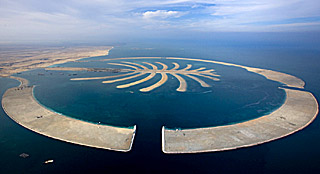 Chief among these mega-projects are a series of ambitious schemes to
create scores of artificial islands off the coast of Dubai, by Nakheel, one of
the world’s largest real estate firms. Nakheel’s projects could add 1,000
kilometres to Dubai’s coastline.
Chief among these mega-projects are a series of ambitious schemes to
create scores of artificial islands off the coast of Dubai, by Nakheel, one of
the world’s largest real estate firms. Nakheel’s projects could add 1,000
kilometres to Dubai’s coastline.
In the process, Nakheel, with holdings of US$60 billion, has become a world leader in creation of artificial islands. First on the map with Palm Jumeirah, whose fronds now host multi-million dollar homes, Nakheel set its sights higher, recently completing the groundwork for the World, and is now constructing an entire Universe, in islands.
“We call this Baby Palm,” jokes Aaron Richarson, Nakheel’s Media Relations manager, as we zip by boat amongst the serene shoreline of the first Palm project. The size of 550 football pitches, it will eventually serve a population of 100,000 residents and resort guests. “It’s huge,” he says, “but there is so much more on the way.”
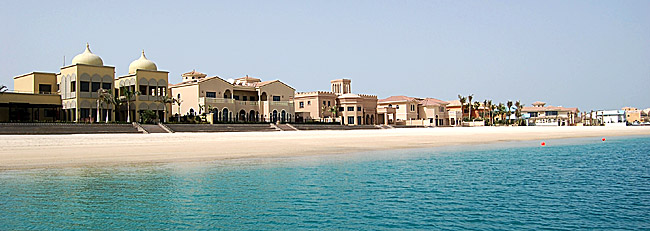
And not just in Dubai. Around the Gulf, island creation is booming. Qatar is building the Pearl, a US$2.5 billion project to create a nearly 1,000-acre island, about the size of Gibraltar. Bahrain has Amwaj and Durrat Al-Bahrain, multi-billion dollar projects that will create nearly 20 islands, seeded with luxury apartments, cinemas and theme parks.
Such schemes have propelled the region into the forefront of the dredging, landfill and real estate industries, attracting attention not only from major investors and builders, but also environmentalists and urban planners. Bloggers have had a field day posting photos of the Palm, Pearl, World and other intriguingly-contoured islands.
Yet, these projects, however outlandish they seem to some, have a strong historical basis, and a global appeal. Ancient Mexico City was built largely on a filled-in lake. In Peru, the Uros, a pre-Incan tribe, still live as they have for centuries, on several dozen floating artificial islands around Lake Titicaca.
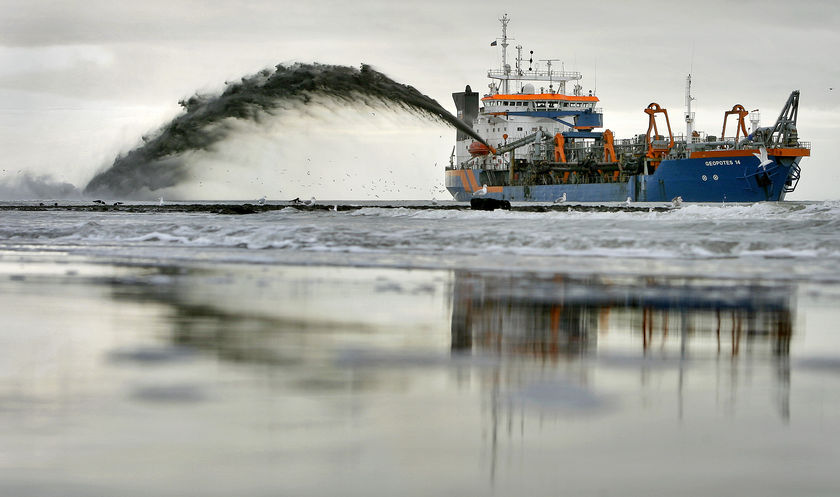 In modern times, major reclamation projects reshaped both Singapore and
Hong Kong, while dredging continues
to provide massive new land for growth in Macau.
The former Portuguese colony is now 10 times its original size.
In modern times, major reclamation projects reshaped both Singapore and
Hong Kong, while dredging continues
to provide massive new land for growth in Macau.
The former Portuguese colony is now 10 times its original size.
Even in the western world, such activities have been commonplace. The Netherlands – literally “low-lying lands” – reclaimed 20 percent of its mass from sea. The Dutch remain the global leader in land reclamation, whether at home, in Hong Kong or the Gulf, thanks to unparalleled experience in pioneering ambitious landfill schemes.
Even spacious America has extensive experience in island creation. New York’s Ellis Island, famous for processing immigrants, is mostly manmade. San Francisco’s Treasure Island was created from scratch seven decades ago for the Golden Gate International Exposition.
In the 1920s, Florida created its Venetian Islands in a controversial real estate scheme that sold underwater plots for future island sites. Far from a thing of the past, such projects remain in vogue. Next year, work should start on a project to turn the former naval base of Treasure Island into a model green community.
Artificial islands have long provided vital space for urban growth and infrastructure, such as for airports, particularly for land-starved Asian cities. Hong Kong’s Chek Lap Kok Airport is on an artificial island; likewise Osaka’s mammoth Kansei. Again, there is a historical precedent. Harbor Island, largest artificial isle of the time, was completed a century ago to provide port facilities for Seattle.
 Probably the most controversial period for artificial islands was in the
1970s, when a series of developers, utopian dreamers and extremists mounted
efforts to spawn new island nations. These included the self-proclaimed Republic
of Minerva, near Tonga, and the Republic of Rose Island, off the Italian coast.
The utopian Transtopia never got past the theoretical stage, but remains
representative of a timeless dream now being realized in the Gulf – providing
a slice of paradise for everyone.
Probably the most controversial period for artificial islands was in the
1970s, when a series of developers, utopian dreamers and extremists mounted
efforts to spawn new island nations. These included the self-proclaimed Republic
of Minerva, near Tonga, and the Republic of Rose Island, off the Italian coast.
The utopian Transtopia never got past the theoretical stage, but remains
representative of a timeless dream now being realized in the Gulf – providing
a slice of paradise for everyone.
But the Gulf has no monopoly on such schemes, even today. In the run up to hosting the 2014 Winter Olympics, Russia has announced plans for Federation Island, a mini-archipelago to replicate the shape of Russia and provide upscale lodging for 30,000 people off the Black Sea resort city of Sochi.
And the Dutch, builders of many of the world’s newest island real estate, may do the same at home. Dutch politician Joop Artsma is pushing a US$15 billion plan to create a 50-kilometre long, 100,000 hectare isle – in the shape of a giant tulip.
Island building has evolved considerably since ancient days of piling grass and dirt in water. But while equipment has grown more complex and techniques more efficient, the essential process is largely the same. Just on a grander scale.
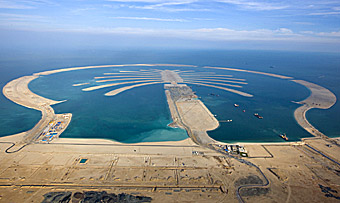 Take the Palm Jumeirah, the world’s largest man-made island when
launched (only Palm Jebel Ali and Palm Deira are bigger). Almost 100 million
cubic metres of sand and seven million tons of crushed rock were used in
creating a 550-hectres isle. The material could have been used to build a two-metre
wall circling the globe three times.
Take the Palm Jumeirah, the world’s largest man-made island when
launched (only Palm Jebel Ali and Palm Deira are bigger). Almost 100 million
cubic metres of sand and seven million tons of crushed rock were used in
creating a 550-hectres isle. The material could have been used to build a two-metre
wall circling the globe three times.
Island creation follows three phases, according to Belgium firm Jan de Nul, which built Palm Jebel Ali and is also working on Abu Dhabi’s Saadiyat Island project. Koen De Bisschop, the Rock Works Area Manager details the phases: removal or consolidation of loose material from the sea bed; creating the island with fill (sand, rock and/or gravel); then creating a sea wall to protect the new island.
The Gulf presents many unique challenges. Shallow waters make it impossible for big boats to navigate, restricting the use of bigger, heavier dredging equipment. However, favorable wind conditions and gentle seas provide benefits, too.
Sand is sucked up from the sea bed with giant hoses, then stored in the dredging ship. For The World, this involved 320 cubic metres of sand, along with 30 million tons of rock, reportedly sufficient material to build a wall like China’s Great Wall, only two metres wide, and four high, all the way around the equator – for 40,000 kilometres.
One unique technique employed in the Gulf is spraying sand atop new isles. Called “rainbowing” it expedites island formation. Global Positioning technology – unavailable in earlier times – makes possible exact placement of material, reducing waste, environmental impact, and facilitating the intriguing island shapes.
Sand is the main material used in Gulf island construction, dredged from the sea, cleaned and drained of water. Unique compactors simulate millions of years of aging. Nakheel projects its isles will settle no more than an inch over 50 years.
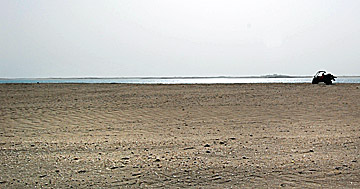 Computer technology also plays its part in the process. Besides actual
laboratory tests of wave impact on island models, 3D simulations help pinpoint
tidal effect. Computers also help in design of the crucial sea wall, erected at
completion to ensure new islands don’t wash away. Computer simulations
determine not only placement, but the shape and means of maximizing water
circulation without damage to the islands.
Computer technology also plays its part in the process. Besides actual
laboratory tests of wave impact on island models, 3D simulations help pinpoint
tidal effect. Computers also help in design of the crucial sea wall, erected at
completion to ensure new islands don’t wash away. Computer simulations
determine not only placement, but the shape and means of maximizing water
circulation without damage to the islands.
Technology also plays a huge role in environmental studies, which are critical – and costly – in each project. Outside agencies are often enlisted to monitor work and advise on environmental protection. The results are surprising.
“We’ve got birds, fish and grass where there was nothing before,” says Richardson. Touring the artificial World, we spy flocks of birds and see swarms of fish in stunning emerald water. Critics remain divided on the islands, but no one disputes the formation of thriving new reef.
Perhaps that’s because quality is crucial to projects that aren’t government driven, but instead must pass the staunchest test – market demand.
Thus far, there are plenty of buyers, and resale values of the first Gulf islands continue to soar. “It’s all about coastline,” Richardson says, pointing that Palm sold out in 72 hours. Proof that island real estate, even manmade, remains precious at any price.
Ron Gluckman is an American reporter who has been based in Asia since 1991, roaming around the region, and beyond for various magazines, including Gulf Air, which ran this story in May 2008.
Photo credits: satellite images of Palm
projects courtesy Nakheel; tulip and dredger from web;
rest by RON GLUCKMAN
To return to the opening page and index
push here
[right.htm]
